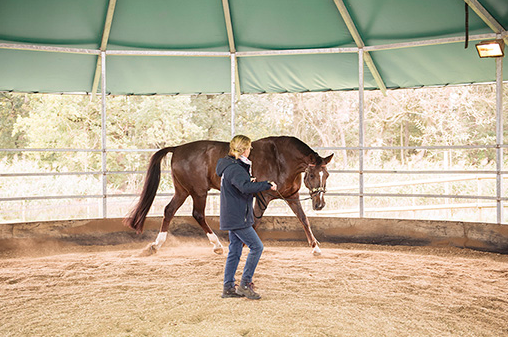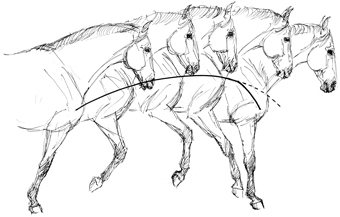Getting started with training after rehabilitation

Patiently you have given your horse time to recover from an illness or injury. Then finally, after a control examination, the vet gives the green light for the rehabilitation phase. You are very happy – and very uncertain. You want to do everything right and strictly follow the vet's instructions. Usually this means to ride straight ahead with the stopwatch on your wrist, then to trot short distances and finally the first canter follows. What seems like a bomb-proof instruction manual back to the sport is in fact in most cases doomed to failure sooner or later.
With the transformation of the horse sector from a military dominated male domain to a female dominated popular sport, the attitude of horse owners towards their animals in case of injury or illness has also changed. The emotional bond is stronger, so that all available means are often used to treat a horse. This has created an extremely lucrative niche market in the equestrian industry, which takes advantage of the fears of horse owners: rehabilitation.
Numerous equestrian clinics and horse sport centers have jumped on this bandwagon and are tempting people with promising support and care offers for horses after training breaks. Where some focus on medical follow-up treatment and advertise therapies accompanied by medication and supervised by a veterinarian, others entice with aqua trainers, massage techniques learned on weekend courses, mud packs and herbal cures. Whether outpatient or inpatient – these offers often lack a holistic approach and especially a thorough analysis of why the acute injury or illness occurred in the first place.
Mostly injuries occur insidiously, lameness comes and goes, horses are considered to lack rideability and to be unwilling until the damage to the fetlock or the acute inflammation in the back can no longer be overlooked and requires veterinary treatment. Colic is also often preceded by unnoticed metabolic problems or stress-related digestive problems. However, the veterinarians and especially the rehabilitation centers concentrate their treatment exclusively on the current trouble spots – which is why they cannot be successful in the long term.
Instead of becoming so dependent on rehab programs and treatment spirals, horse owners must clearly accept their responsibility and become therapists for their horses themselves. This can be a painful experience, as it often requires a drastic rethinking by the horse owner. Especially in today's feminine horse environment, there are many "helicopter owners" who have forgotten to take a step back in order to assess a situation because of their self-sacrificing concern for their four-legged friend. Rather, they crawl into their horse and, in their humanization of the animal, overlook the fact that they themselves are part of the problem of their horses. Thus, certain stereotypical behaviors in the horse are triggered by the presence of the owner alone, or the owner accuses the horse of being ungrateful after all the time and money one has spent on the horse in the time of illness or injury and later in rehabilitation – and now the horse may still not let itself be groomed by the owner, shows resistance or even suffers a relapse of injury or illness.
It is a fact that many horses after the rehabilitation programs are in the same place as before the injury or illness. However, if the question of "why" has not been asked and the root of the problem has not been tackled, this status may not be sufficient to keep the horse healthy in the long run.
In the vast majority of cases, the entire concept of rehabilitation training must be fundamentally questioned and a new basic training must be started with horses in rehabilitation. Numerous behavioral problems, injuries and illnesses are essentially an expression of the body's inability to deal with the forces and strains that act on the horse during riding. These must be tackled by an experienced trainer, if necessary accompanied by veterinarians and therapists, and always together with the horse owner! In addition to the training of horse and rider, this new start also includes a critical analysis of the other training factors, for example the saddle, shoeing and feeding. This process requires the horse owner to be willing to change his own behavior and to cut off old habits which, due to a lack of knowledge, may have been considered good and correct for years.
Only if the owner recognizes his responsibility and fulfils his role as trainer of his horse, rehabilitation has a long-term chance of success. This requires from the owner the willingness to acquire knowledge about anatomy and biomechanics and thus the functional training of horses. The owner will have to learn that, for example, riding straight ahead does not spare the horse at all, but that straightening the horse on curved lines alone takes the horse out of the stressful biomechanics of the flight animal and makes it an athlete – a requirement that must be met by sport and leisure horses alike. Whether working on the ground or under saddle: targeted and planned training by the owner is the only guarantee for the long-term health of our horses.
